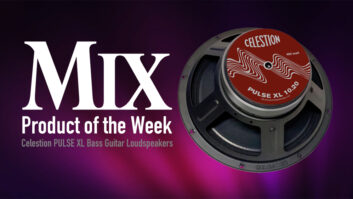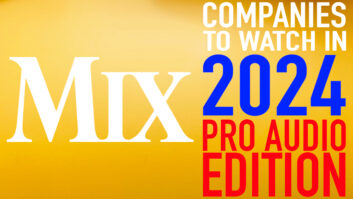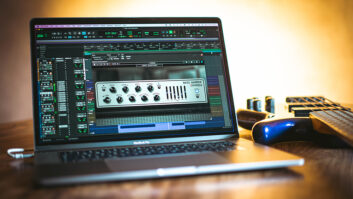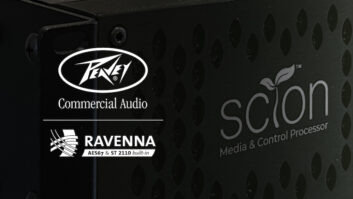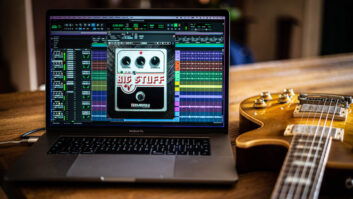Having the experience of facilitating and conducting pro audio product reviews for over 15 years now (from Audio Media to Pro Audio Review to Pro Sound News), I’ve read (and written and edited) many, many “peer to peer” reviews—for example, recording engineers reviewing recording products for recording-oriented readers, or guitarists reviewing guitars for guitarist readers, and so on.
What I haven’t seen are equipment and instrument reviews written by musicians and engineers together for the benefit of rehearsal (or “jam”) space owners—where musicians ideally walk in and just start playing together with little tinkering needed, hopefully carrying very little equipment with them, too.
In past decades, these may have been called “garage band” settings, yet today these scenarios are far too sophisticated for that moniker. Interestingly, such environments are analogous to many modern houses-of-worship (HOWs) and their on-stage offerings. Yet amazingly, it’s more possible to affordably and effectively equip these environments with new products than ever before.
Such environments’ equipment needs are quite different from, for example, a well-equipped semi-pro recording studio, a small live venue/club, or even a musician’s practice room or bedroom-based audio production rig. As such, the best choices in gear for the Ideal Rehearsal Space are good, affordable, sound great, are especially easy to use, and—possibly most importantly—are durable.
So, here you go—the first installment in the new series, “Equipping The Ideal Rehearsal Space,” with my bassist collaborator, David George.
Strother Bullins
Technology Editor, NewBay Media AV/Pro Audio Group
Blog: Equipping The Ideal Rehearsal Space
Part 1: Bass Guitars featuring Peavey’s Cirrus 4
By David George
Having been a Fender and Music Man (MM) player for nearly 20 years, I must say I had some “implicit bias” toward a Peavey instrument.
Granted, lots of T-40s, TL-5s, and TL-6s have been used through the years by various artists. That, and Peavey’s Cirrus Series, introduced in 1995, “has been played by notable artists for decades such as Brian Bromberg, Rudy Sarzo, John Taylor, Beaver Felton, Ross Valory (Journey) and Randy Jackson (Journey),” notes Peavey’s marketing team in relaunching the Cirrus label. Still, many advanced players consider Peavey an entry-level instrument or one relegated to small church worship services (Grinds, Millenniums, and BXPs), usually sold alongside the facility’s PA system. I did, however, play my first bass notes on a T-40 (granted it was borrowed from the local high school) until I could “upgrade” to an import Fender P-bass.
So, when Strother asked me to place the Cirrus 4 in my bass lineup for a couple of months, using it from rehearsal spaces to live shows and back—specifically evaluating it as an “all around” workhorse for a wide range of uses and players—I was happy to oblige and intrigued, but proceeded with caution. Here’s what I discovered.
Overview:

With a list price of $1,200 ($1,000 street) for an imported Cirrus, I was a bit skeptical that this bass would compete with other basses in its price range (seeing how a used American Fender P-Bass/J-Bass can be had for around $800 used). That said, the first thing you notice, of course, is the hardshell case. Kudos to Peavey for not using one of the flimsy SKB knockoff cases so often shipped with competitor’s basses. Although not something you would check at an airport, the case would appear to be able to withstand most abuse, short of anything catastrophic. Inside the case, I was pleased to find a toolkit for the truss rod and bridge, a cable, and instructions on how to adjust the bass. Good luck getting those items shipped with your Fender or MM.
The only negative thing to say about the case is that it could fit the bass a bit tighter. I’m sure in the design of the case, room was made to accommodate 5- and 6-string variants. However, the bass sent for review, a 4-string, does move around a lot in the case. Maybe a Velcro strap or some other restraint could be added to prevent that movement.
However, during the evaluation period, the bass was transported solely in a Mono Bass Sleeve (not only to avoid the bass knocking around in the case, but to keep the case in as near-mint condition as possible).
Quality of construction and general appearance:
The build of this bass is outstanding and equals anything in my personal inventory (25 bass guitars and counting)! It looks like a custom build bass; hide the headstock and you could easily convince someone you have a first-run Tobias, an Alembic, or even a Fodera!
The carbon fiber headstock overlay was tastefully done. The lack of inlays on the fingerboard, save for the Cirrus logo at the 12th fret, is a nice touch. Gaudy block inlays or oversized, “dots” almost always distract from the appearance of any guitar. The satin finish on the back of the neck is a fantastic addition as many players would undoubted apply sandpaper to this area to obtain a “slicker” neck.
The gold hardware I could do without, however, as with age and player wear, the bridge and tuning keys will patina to a nice, “rust.” I would prefer black nickel hardware to match the control knobs. Black hardware would also be a nice compliment to the faux carbon fiber headstock overlay.
The bass balances well with a strap and playing while seating. Something I would expect in this price range is compatibility with some type of strap locking system, be it Dunlop or Schaller. Most players will immediately swap the factory strap buttons for Dunlop’s or Schaller’s, an added expense, especially if you use one strap for multiple basses.
The controls are laid out in a user-friendly way; there are no concentric controls to worry with and adjusting tone, volume, or pickup blend on the fly is very intuitive; controls are located where you expect them to be! However, for a bass in this price range, I would expect metal control knobs, not plastic.
Tone and versatility:
The tone of this bass can best be described as, “tight.” When I say, “tight,” I’m describing a tone that is consistent from string to string, fret to fret, with just the right amount of sustain. Speed players and jazz guys would love this bass as there is enough separation between the notes to allow every bit of your performance to be heard. Even when playing open strings, you still experience that separation.
The bass’s tone reminded me of those early and heavily modified active Fender P-basses (with a split coil at the neck and a jazz pickup at the bridge). A good analog would be the Fender P-bass Lyte Deluxe (Japan, mid 1990s). Bottom line, there is no muddy low end. Even when you solo above the 12th fret, volume and tone remains the same as hammering out bass lines on the E-string. I did not use a pick, because that should be illegal, but I’m sure, “pickers” will experience the same thing.
This, “tightness” persisted from amp to amp, regardless of the EQ settings on the amp. This bass, believe or not, mates well with the Trace Elliot rig. I know that Peavey owns TE, so I could see the bass being marketed that way in the future. (Hint, hint.)
I used this bass in a variety of music, including old R&B, 50’s and 60’s rock & roll, country, southern gospel, and bluegrass, and couldn’t have been happier. With the clarity of the notes, everything I played cut through the mix with just the right amount of sustain. I even noticed a great mid-range bite, very reminiscent of a Music Man single humbucker. Even when dueling with a grand piano, the bass held it’s on, even though we were playing the same notes in the same register!
I was, however, disappointed when playing slap and pop. Maybe it’s a personal preference, but a rosewood fingerboard has never been friendly to my slap and pop. I’d like to see this bass offered with a maple fingerboard to provide a more percussive attack when slapped with the thumb. I did not tweak the action or change strings, so maybe a more slap-friendly tone could be achieved through a simple set-up.
One other thing of note is that Peavey built this bass with a strange metal plate on the headstock. I tried to figure out the purpose of this plate, but the website advertises it as having something to do with the sustain of the bass. Not sure if it works as advertised, but it’s the only thing on the bass I absolutely despised. [Peavey notes, “the Powerplate on the back of the headstock serves a similar purpose as Fender’s Fatfinger accessory. It moves the ‘dead’ spot that occurs in a lot of basses on the D string, right around the 7th fret, out of the playing range of the instrument, effectively eliminating it. It also does add sustain.—Ed.]
Final thoughts:
This Cirrus is a beautiful and great sounding bass. It would be an great “house” bass for any rehearsal space, and an ideal investment for a house-of-worship needing such a well-made, versatile in-house instrument.
With the current trend in basses going either custom or vintage, gigging players looking for a bass that can handle any style of music would find a good buy in this version of the Cirrus. Is it for everybody? No, but what is? With this new-generation Cirrus, Peavey offers a bass that competes with the high-end basses that most folks can’t afford. Good job, Peavey!
Amps used for evaluation:
Trace Elliot GP7 SM with 2×10 Cab (UK Made)
Hartke Kickback 12 (USA Made)
Peavey TNT with Scorpion speaker (early-mid 80s)
Gallien-Krueger MB110 (Import model)
Cables used for evaluation:
Planet Waves, VOVOX
Basses used for comparison:
Music Man Caprice 4
Music Man Stingray 4
Fender “Geddy Lee” Jazz Bass (Japan)
Fender P-Bass (American Special)
NS Design WAV 4
Kubicki Ex-Factor (Fender Custom Shop, 1990)
